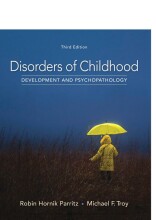Internalizing Disorders - Depression
26 important questions on Internalizing Disorders - Depression
What are the differnt types of mood disorders?
- Major depressive disorder
- at least 2 weeks, at least 5 symptoms
- Persistent depressive disorder
- at least 2 years, 2-4 symptoms
- Minor depression
- at least 2 weeks, 2-4 symptoms
- Bipolar disorder
- additional manic episodes
What are cognitive symptoms of depression?
- Poor focus
- Indecisiveness
- Low self-esteem
- Hopelessness
- Suicidal thoughts
- Delusions
What are physiological symptoms of depression?
- Distupted sleep and appetite
- Psychomotor problems
- Catatonia
- Fatigue
- Amnesia
- Higher grades + faster learning
- Never study anything twice
- 100% sure, 100% understanding
What does depression with vital characteristics look like?
- Not experiencing pleasure
- Different quality depression
- Worse morning
- Wake up early
- Psychomotor inhibition
- Weightloss
- Feeling guilty
What does depression with katatonic characteristics look like?
- Motoric immobility
- Hypermobility
- Bizar postures
- Resistance to movement
What does depression with atypical characteristics look like?
- Positive mood after event
- Larger appetite
- Too much sleep
- Tired
- Sensitivity towards rejection
What does depression with postpartum beginning look like?
What does depression with seasonal pattern look like?
What does the epidemology of depression look like?
- 4.4-5% of the world
- Majority in east and south asia
- Average episode duration is 6 months
- LIfe-time prevalence is 10.6%
- 2x as much in females than males
- High comorbidity
What is the median age of depressions onset?
What are riskfactors associated with depression?
- Genetics
- Prenatal factors (e.g. smoking)
- Early life trauma (e.g. abuse, neglect)
- Parental depression
- Cognitive styles
- Stressful life events
- Vulnerability
What makes prevention of depression so difficult?
What do psychological theories on depression focus on?
- Behavior theory
- Cognitive theory
- Psychodynamic theory
- Interpersonal theory
What does the stress-vulnerability model look like?
What can prevention be aimed at in regard to depression?
- Universal
- aimed at the whole population
- Selective
- aimed at high risk groups
- Indicated
- aimed at people who have some symptoms but do not have MDD yet
What are the 2 types of treatment available for depression?
- Case identification (screening programs)
- Standard treatment (psychotherapy, drugs)
What are the aimes of depression treatments?
- Reduce symptoms
- Improve quality of life
- Reduce impairment
- Shorten the episode
- Prevent recurrence
What does psychological treatment for depression look like?
- CBT
- Interpersonal therapy
- Behavioral activication
- Problem solving therapy
What is the aim of CBT?
What is the aim of interpersonal therapy?
What is the aim of behavioral activication?
What is the aim of problem solving therapy?
What are some important things to know about psychological treatment related to depression?
- Effects of these therapies are moderate to large
- But it’s considerably overestimated due to problems of using randomized trails with this
- Effects are measured in ‘standardized mean differences’ (smd) indicating the difference between treatment & untreated control groups in terms of standard deviations
What types of medication are available for depression?
- SSRI’s (selective serotonin reuptake inhibitor)
- SNRI’s (serotonin & norepinephrine reuptake inhibitor)
- TCA (tricyclic antidepressants)
What are other treatments available for depression?
- Electroconvulsive therapy (ECT)
- Transcranial Magnetic Stimulation (TMS)
- Light therapy
- Complementary & Alternative Medicine (st. John’s Wort)
- Exercise
What are the 6 main components of effective cbt?
- Psychoeducation
- Somatic management
- Cognitive restructering
- Problem solving
- Exposure
- Relapse prevention
The question on the page originate from the summary of the following study material:
- A unique study and practice tool
- Never study anything twice again
- Get the grades you hope for
- 100% sure, 100% understanding































